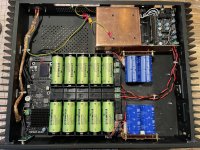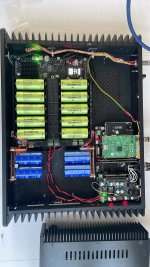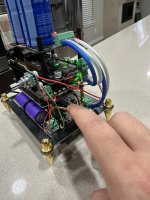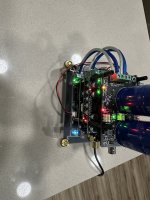Now we have a renewed flush of activity with Ian's new GB, I thought I'd try to get some advice on an ongoing issue.
Pops between tracks.!
If I select a different track (Volumio) Tidal or change the radio channel j get awful pops/cracks that really can't be doing the tweeter any good.
I was told it was probably to do with sample rates
I have a Fifo with 2 x NDK clocks installed. It does it if I have the software force an oversample to a given rate, or of I leave it native.
Does it either with my Miro AD1862 or Abrax Dorati
I intend to eventually implement the Sinepi I bought ages ago with 2 X Mori clocks. Would this help ( assuming maybe wrongly that the relay on the Sinepi would help this)
Pops between tracks.!
If I select a different track (Volumio) Tidal or change the radio channel j get awful pops/cracks that really can't be doing the tweeter any good.
I was told it was probably to do with sample rates
I have a Fifo with 2 x NDK clocks installed. It does it if I have the software force an oversample to a given rate, or of I leave it native.
Does it either with my Miro AD1862 or Abrax Dorati
I intend to eventually implement the Sinepi I bought ages ago with 2 X Mori clocks. Would this help ( assuming maybe wrongly that the relay on the Sinepi would help this)
How are you struggling?, I had to go out and buy a Large soldering Iron to get it to work correctly my Normal soldering Iron made a mess of Things,, If you have not done soldeing before , see if someone in an electrical or plumber store near you can do it https://www.amazon.co.uk/gp/product/B09CZ2W99J/ref=ppx_yo_dt_b_asin_image_o05_s00?ie=UTF8&th=1 ,Hi everyone,
I am really struggling to solder Maxwell ultra capacitor to UCConditioner 3.3V. I have not used solder before. I'm scared i'll end up destroying the UCConditioner board. Is there an alternative to soldering, like some kind of conductive glue that hardens.
Thanks in advance.
Hello,
What most people don't seem to realize is that you need a BIG tip to have the best heat transfer possible so you dont need to put a tip for a to long time on the board. The longer the temperature takes to go up the more the parts will suffer.
A bad solder joint that looks ok for most of us is not hard to make. Of course people will think , for these six solder joints i won't buy a new tool.
Greetings Eduard
What most people don't seem to realize is that you need a BIG tip to have the best heat transfer possible so you dont need to put a tip for a to long time on the board. The longer the temperature takes to go up the more the parts will suffer.
A bad solder joint that looks ok for most of us is not hard to make. Of course people will think , for these six solder joints i won't buy a new tool.
Greetings Eduard
That is of course not possible without ASRC or PLL. But it is possible to use "non-audio" sampling rates with USB audio class as it is not limited to fixed sampling rates. E.g. Windows UAC2 driver works happily with non-standard sampling rates. With asynchronous UAC the host sampling rate does not even have to be exact as device clock is the master. So it is possible to make a Windows audio player that works with a DAC having 10MHz MCK even without resorting to ASRC or PLL.If you play a 192KHz 32bit music, the SCK frequency will be 12.2880MHz, how can you run your DAC with a 10MHz MCLK?
It's probably adjusting the timing of the audio frequency clock. Ian boards don't do that.
I use a GPSDO ocxo clock for ntp to keep my pc switch and streamer running audiolinux all in correct time sync. This made a huge difference. I would try and use your clock for ntp on the network and let the sc pure so the audio which is an extremely impressive clock
I use a GPSDO ocxo clock for ntp to keep my pc switch and streamer running audiolinux all in correct time sync. This made a huge difference. I would try and use your clock for ntp on the network and let the sc pure so the audio which is an extremely impressive clock
I’ve built a streamer and I’m so happy with it. I know there are upgrades to do and it’ll come.
I would like to turn it into a Dac. What is the best solution if I don’t need a balanced output but need a single ended rca?
I would like to turn it into a Dac. What is the best solution if I don’t need a balanced output but need a single ended rca?
Attachments
Hello,
I would wait a few months for the DDDAC mk3 to appear.
You will get great support and it looks like there is less problems popping with Dddac users than you see here.
It looks like the newer boards from Doede will be almost like plug and play with some basic soldering .
Greetings Eduard
I would wait a few months for the DDDAC mk3 to appear.
You will get great support and it looks like there is less problems popping with Dddac users than you see here.
It looks like the newer boards from Doede will be almost like plug and play with some basic soldering .
Greetings Eduard
Hi folks,
I want to build a Streamer that only uses I2S, nothing else.
It will be used as a Diretta Target with GentooPlayer.
I have a lot of doubt about Ian Canada's power supplies.
Which power supply do you believe provides the best audio quality? Is there a verdict on this?
I want to build a Streamer that only uses I2S, nothing else.
It will be used as a Diretta Target with GentooPlayer.
I have a lot of doubt about Ian Canada's power supplies.
Which power supply do you believe provides the best audio quality? Is there a verdict on this?
I took the MonitorPiPro out and re-inserted it. That powered it on. But now i'm get nosig on the Monitor PiPro screen. I'm feeding input from Holo Red DDC RCA coax output. I checked by putting the Holo Red output directly to the DAC and there is sound. Do I need to somehow select the input on ReceiverPiDDC ?Please make sure the MonitorPiPro is installed into correct GPIO position without any pins shifted. Otherwise can result-in a short circuit.
Did you enable DDC in the MonitorPi Pro settings? Please download both MonitorPiPro and ReveiverPi DDC user's manuals and read them.
Please do it step by step, first make sure the DDC receives signals correctly, then the FifoPi working correctly, and finally you can get correct output to your DAC.
Please do it step by step, first make sure the DDC receives signals correctly, then the FifoPi working correctly, and finally you can get correct output to your DAC.
Advise to all builders
1. Download all the manuals for your build
2. Read those manuals MANY times so you are clear
3. Test power supplies BEFORE you connect them to any modules - critical step
4. Build the modules up in stages and where you can test as you go, triple check connections and ensure cables are in the right places
5. Ensure and check many times the modules are plugged in correctly BEFORE you power anything up.
6. When you power up check the correct LEDs are lite
7. Select the right settings if using MonitorPi
8. Most important is TAKE YOUR TIME and TRIPLE check everything before you power up
Hope this helps and many more points can be added to this list but these are the basics to follow in my experience. What I see here is many might not be reading the manuals or don’t understand the manuals, if this is you as on here for help rather than trying and making expensive mistakes
Good luck and happy building 🙂
1. Download all the manuals for your build
2. Read those manuals MANY times so you are clear
3. Test power supplies BEFORE you connect them to any modules - critical step
4. Build the modules up in stages and where you can test as you go, triple check connections and ensure cables are in the right places
5. Ensure and check many times the modules are plugged in correctly BEFORE you power anything up.
6. When you power up check the correct LEDs are lite
7. Select the right settings if using MonitorPi
8. Most important is TAKE YOUR TIME and TRIPLE check everything before you power up
Hope this helps and many more points can be added to this list but these are the basics to follow in my experience. What I see here is many might not be reading the manuals or don’t understand the manuals, if this is you as on here for help rather than trying and making expensive mistakes
Good luck and happy building 🙂
Hello Simon,
Reading is a serious virtue that most people , especially the young ones don't have.
Two decades ago you could see some people reading books and newspapers while sipping their coffee outside. Now i meet even 30 years old who cannot properly construct a sentence in their own language. Better get used to it.
Writing a manual that can be understood by average intelligence people reading in a foreign language is a serious job. It is also about " layout " much information there that could be ditched and the information that is crucial can be found reading in between the lines.
Every board having its own manual sometimes can add some confusion too.
Maybe there should be a kind of " booklet" to explain what is happening in all these connected boards and why it " needs to be like this ". A few weeks ago there was a nice " schedule" with a bunch of boards also showing the connecting wires .
Of course this will take time to make but earning the money for a pile of boards also takes time.
Spewing out lower number of boards and ending up with a greater percentage of buyers getting things to work would be a nice goal or are we just like the old vacuum cleaner salesman hunting for targets?
Could well be because people seem to think things only get better by buying updated boards while using common sense with things already on your bench could be much more satisfying.
Last week i talked with some mechanics whose job is about the complete electrical system of trains. 99% of malfunctioning is not because of cables being corroded/ damaged no it is in the area where the cable starts or ends. The crimping was done with the wrong tool, the wrong momentum during fastening , the usual culprits. And here where we all try to impress them others with the latest super spec caps but we just use a thick cable and think we are there.
The French audiophiles around Jean Hiraga already published articles how to preserve/ maintain the high tech specs of the caps they were prescribing. Maybe back then people were more fanatical about this hobby.
Now sometimes i just laugh like my co workers do. What they use these caps like this??
Greetings,Eduard
Reading is a serious virtue that most people , especially the young ones don't have.
Two decades ago you could see some people reading books and newspapers while sipping their coffee outside. Now i meet even 30 years old who cannot properly construct a sentence in their own language. Better get used to it.
Writing a manual that can be understood by average intelligence people reading in a foreign language is a serious job. It is also about " layout " much information there that could be ditched and the information that is crucial can be found reading in between the lines.
Every board having its own manual sometimes can add some confusion too.
Maybe there should be a kind of " booklet" to explain what is happening in all these connected boards and why it " needs to be like this ". A few weeks ago there was a nice " schedule" with a bunch of boards also showing the connecting wires .
Of course this will take time to make but earning the money for a pile of boards also takes time.
Spewing out lower number of boards and ending up with a greater percentage of buyers getting things to work would be a nice goal or are we just like the old vacuum cleaner salesman hunting for targets?
Could well be because people seem to think things only get better by buying updated boards while using common sense with things already on your bench could be much more satisfying.
Last week i talked with some mechanics whose job is about the complete electrical system of trains. 99% of malfunctioning is not because of cables being corroded/ damaged no it is in the area where the cable starts or ends. The crimping was done with the wrong tool, the wrong momentum during fastening , the usual culprits. And here where we all try to impress them others with the latest super spec caps but we just use a thick cable and think we are there.
The French audiophiles around Jean Hiraga already published articles how to preserve/ maintain the high tech specs of the caps they were prescribing. Maybe back then people were more fanatical about this hobby.
Now sometimes i just laugh like my co workers do. What they use these caps like this??
Greetings,Eduard
I know Edward and agree. We are building HiFi and not trains of course
@iancanada i do agree the community would really benefit with a PDF covering suggested integrations of your core modules and PSU options with settings
If you did this it will also reduce the calls for help we are seeing
Once the GB is over maybe you would have time for this as would really help
@iancanada i do agree the community would really benefit with a PDF covering suggested integrations of your core modules and PSU options with settings
If you did this it will also reduce the calls for help we are seeing
Once the GB is over maybe you would have time for this as would really help
- Home
- Source & Line
- Digital Line Level
- Asynchronous I2S FIFO project, an ultimate weapon to fight the jitter



